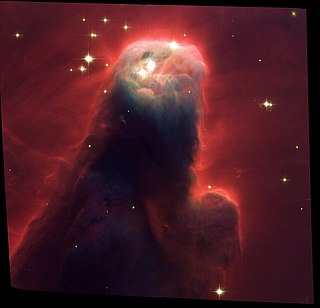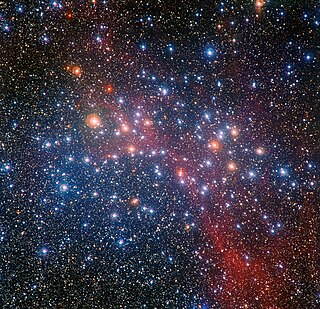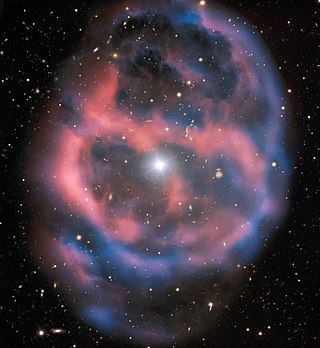
NGC 2264 is the designation number of the New General Catalogue that identifies two astronomical objects as a single object: the Cone Nebula, and the Christmas Tree Cluster. Two other objects are within this designation but not officially included, the Snowflake Cluster, and the Fox Fur Nebula. All of the objects are located in the Monoceros constellation and are located about 720 parsecs or 2,300 light-years from Earth. Due to its relative proximity and large size, it is extremely well studied. NGC 2264 is sometimes referred to as the Christmas Tree Cluster and the Cone Nebula. However, the designation of NGC 2264 in the New General Catalogue refers to both objects and not the cluster alone. In December 2023, NASA released Christmas holiday-related images by the James Webb Space Telescope, including the Christmas Tree Galaxy Cluster and others.

The Red Spider Nebula is a planetary nebula located near the heart of the Milky Way, in the northwest of the constellation Sagittarius. The nebula has a prominent two-lobed shape, possibly due to a binary companion or magnetic fields and has an S-shaped symmetry of the lobes – the lobes opposite each other appear similar. This is believed to be due to the presence of a companion to the central white dwarf. However, the gas walls of the two lobed structures are not at all smooth, but rather are rippled in a complex way.

The Cat's Eye Nebula is a planetary nebula in the northern constellation of Draco, discovered by William Herschel on February 15, 1786. It was the first planetary nebula whose spectrum was investigated by the English amateur astronomer William Huggins, demonstrating that planetary nebulae were gaseous and not stellar in nature. Structurally, the object has had high-resolution images by the Hubble Space Telescope revealing knots, jets, bubbles and complex arcs, being illuminated by the central hot planetary nebula nucleus (PNN). It is a well-studied object that has been observed from radio to X-ray wavelengths.

The Eagle Nebula is a young open cluster of stars in the constellation Serpens, discovered by Jean-Philippe de Cheseaux in 1745–46. Both the "Eagle" and the "Star Queen" refer to visual impressions of the dark silhouette near the center of the nebula, an area made famous as the "Pillars of Creation" imaged by the Hubble Space Telescope. The nebula contains several active star-forming gas and dust regions, including the aforementioned Pillars of Creation. The Eagle Nebula lies in the Sagittarius Arm of the Milky Way.

The Eskimo Nebula, also known as the Clown-faced Nebula, Lion Nebula, or Caldwell 39, is a bipolar double-shell planetary nebula (PN). It was discovered by astronomer William Herschel in 1787. The formation resembles a person's head surrounded by a parka hood. It is surrounded by gas that composed the outer layers of a Sun-like star. The visible inner filaments are ejected by a strong wind of particles from the central star. The outer disk contains unusual, light-year-long filaments.

Minkowski 2-9, abbreviated M2-9 is a planetary nebula that was discovered by Rudolph Minkowski in 1947. It is located about 2,100 light-years away from Earth in the direction of the constellation Ophiuchus. This bipolar nebula takes the peculiar form of twin lobes of material that emanate from a central star. Astronomers have dubbed this object as the Twin Jet Nebula because of the jets believed to cause the shape of the lobes. Its form also resembles the wings of a butterfly. The nebula was imaged by the Hubble Space Telescope in the 1990s.

Astronomy Picture of the Day (APOD) is a website provided by NASA and Michigan Technological University (MTU). According to the website, "Each day a different image or photograph of our universe is featured, along with a brief explanation written by a professional astronomer." The photograph does not necessarily correspond to a celestial event on the exact day that it is displayed, and images are sometimes repeated. However, the pictures and descriptions often relate to current events in astronomy and space exploration. The text has several hyperlinks to more pictures and websites for more information. The images are either visible spectrum photographs, images taken at non-visible wavelengths and displayed in false color, video footage, animations, artist's conceptions, or micrographs that relate to space or cosmology. Past images are stored in the APOD Archive, with the first image appearing on June 16, 1995. This initiative has received support from NASA, the National Science Foundation, and MTU. The images are sometimes authored by people or organizations outside NASA, and therefore APOD images are often copyrighted, unlike many other NASA image galleries.

The Cone Nebula is an H II region in the constellation of Monoceros. It was discovered by William Herschel on December 26, 1785, at which time he designated it H V.27. The nebula is located about 830 parsecs or 2,700 light-years away from Earth. The Cone Nebula forms part of the nebulosity surrounding the Christmas Tree Cluster. The designation of NGC 2264 in the New General Catalogue refers to both objects and not the nebula alone.

NGC 2438 is a planetary nebula in the southern constellation of Puppis. Parallax measurements by Gaia put the central star at a distance of roughly 1,370 light years. It was discovered by William Herschel on March 19, 1786. NGC 2438 appears to lie within the cluster M46, but it is most likely unrelated since it does not share the cluster's radial velocity. The case is yet another example of a superposed pair, joining the famed case of NGC 2818.

NGC 7027, also known as the Jewel Bug Nebula, is a very young and dense planetary nebula located around 3,000 light-years from Earth in the constellation Cygnus. Discovered in 1878 by Édouard Stephan using the 800 mm (31 in) reflector at Marseille Observatory, it is one of the smallest planetary nebulae and by far the most extensively studied.

The Crescent Nebula is an emission nebula in the constellation Cygnus, about 5000 light-years away from Earth. It was discovered by William Herschel in 1792. It is formed by the fast stellar wind from the Wolf-Rayet star WR 136 colliding with and energizing the slower moving wind ejected by the star when it became a red giant around 250,000 to 400,000 years ago. The result of the collision is a shell and two shock waves, one moving outward and one moving inward. The inward moving shock wave heats the stellar wind to X-ray-emitting temperatures.

NGC 6302 is a bipolar planetary nebula in the constellation Scorpius. The structure in the nebula is among the most complex ever observed in planetary nebulae. The spectrum of NGC 6302 shows that its central star is one of the hottest stars known, with a surface temperature in excess of 250,000 degrees Celsius, implying that the star from which it formed must have been very large.

NGC 3532, also commonly known as the Pincushion Cluster, Football Cluster, the Black Arrow Cluster and the Wishing Well Cluster, is an open cluster some 405 parsecs from Earth in the constellation Carina. Its population of approximately 150 stars of 7th magnitude or fainter includes seven red giants and seven white dwarfs. On 20 May 1990 it became the first target ever observed by the Hubble Space Telescope. A line from Beta Crucis through Delta Crucis passes somewhat to the north of NGC 3532. The cluster lies between the constellation Crux and the larger but fainter "False Cross" asterism. The 4th-magnitude Cepheid variable star x Carinae appears near the southeast fringes, but it lies between the Sun and the cluster and is not a member of the cluster.

A bipolar nebula is a type of nebula characterized by two lobes either side of a central star. About 10-20% of planetary nebulae are bipolar.

NGC 7635, also known as the Bubble Nebula, Sharpless 162, or Caldwell 11, is an H II region emission nebula in the constellation Cassiopeia. It lies close to the open cluster Messier 52. The "bubble" is created by the stellar wind from a massive hot, 8.7 magnitude young central star, SAO 20575 (BD+60°2522). The nebula is near a giant molecular cloud which contains the expansion of the bubble nebula while itself being excited by the hot central star, causing it to glow. It was discovered in November 1787 by William Herschel. The star BD+60°2522 is thought to have a mass of about 44 M☉.

The Iris Nebula is a bright reflection nebula in the constellation Cepheus. The designation NGC 7023 refers to the open cluster within the larger reflection nebula designated LBN 487.

The Dark Doodad Nebula is a dark nebula near the globular cluster NGC 4372, much closer than the centre of the galaxy and in the galactic plane, having a length of nearly three degrees of arc. Although officially unnamed, this long molecular cloud has come to be known under this name. It can be found in the southern constellation of Musca with strong binoculars.

Little Ghost Nebula, also known as NGC 6369, is a planetary nebula in the constellation Ophiuchus. It was discovered by William Herschel.
Abell 7 is a faint planetary nebula located 1800 light-years away in the constellation of Lepus. It has a generally spherical shape about 8 light-years in diameter. Within the sphere are complex details that are brought out by narrowband filters. Abell 7 is estimated to be only 20,000 years old, but the central star, a fading white dwarf, is estimated to be some 10 billion years old.

Abell 36 is a planetary nebula located 780 light years away in the constellation of Virgo.




















